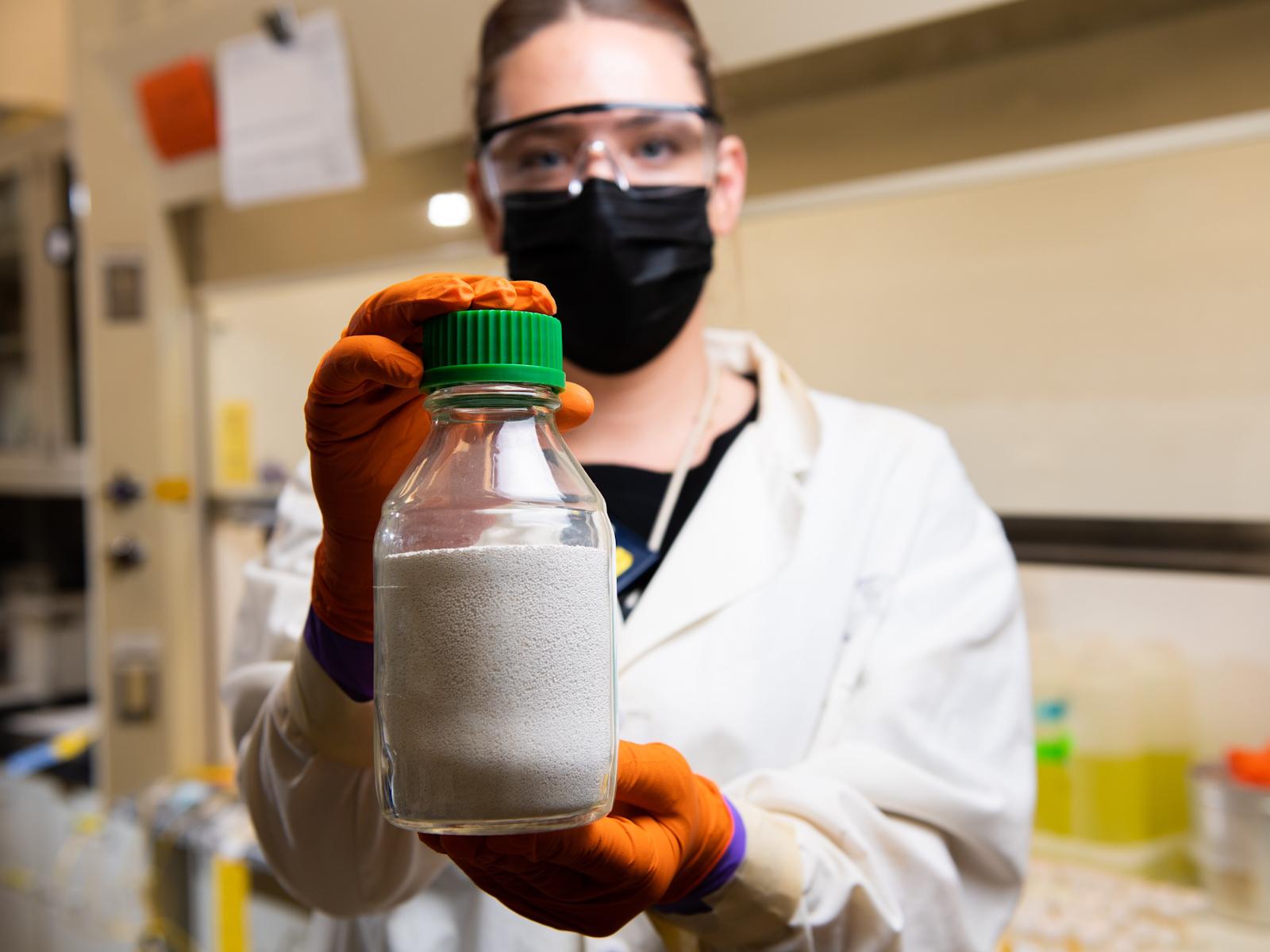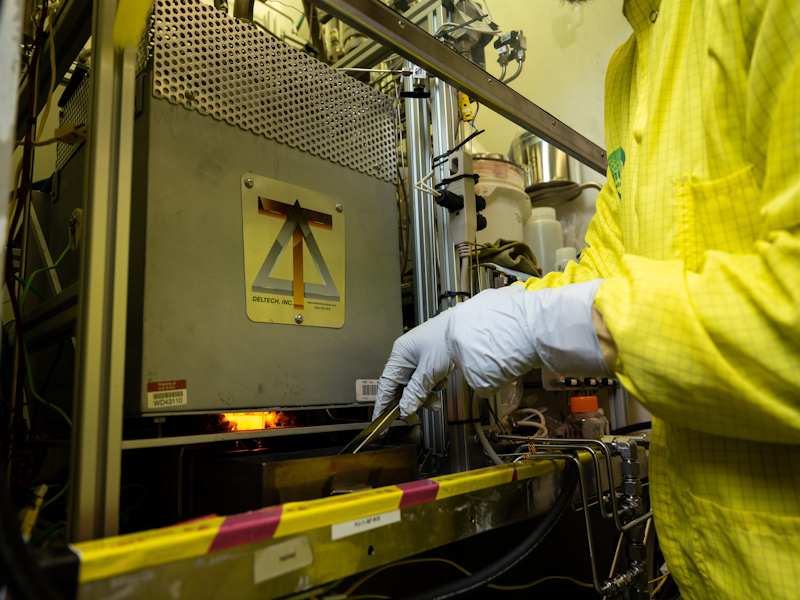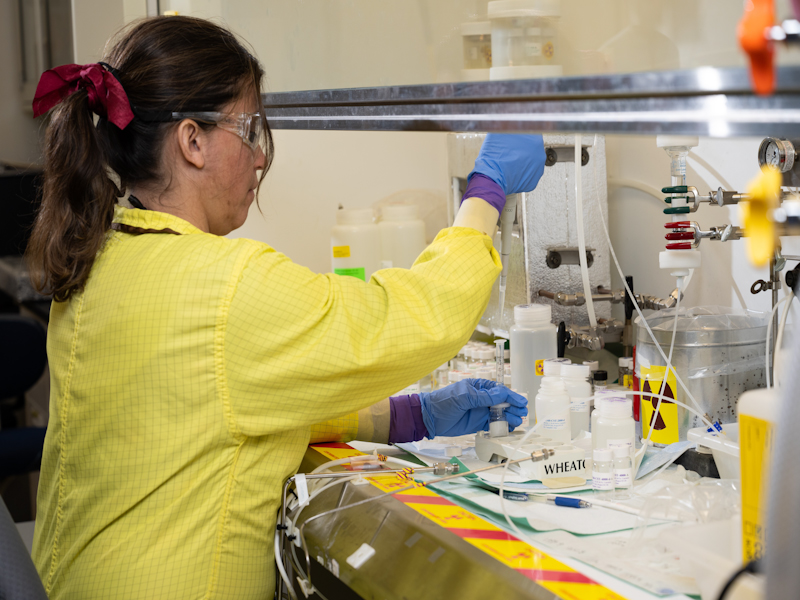PNNL Provides Science and Technology for Hanford Cleanup

Amy Westesen, a chemical engineer at PNNL, is testing the effectiveness of using materials like this to absorb cesium and strontium from the chemical and radioactive waste in Hanford’s tanks.
(Photo by Andrea Starr | Pacific Northwest National Laboratory)
For many in the Tri-Cities, “Waste Management” is name of the company that collects our household trash. But for a cadre of scientists and engineers at the Department of Energy’s Pacific Northwest National Laboratory, it embodies a critical effort to clean up the legacy of decades of nuclear weapons production at the nearby Hanford Site.
Our researchers provide ongoing technical support for the first-of-its-kind Waste Treatment and Immobilization Plant being built and commissioned by Bechtel National, Inc.
Their science and engineering help to underpin the plant’s vitrification process, which involves feeding radioactive and chemical waste along with glass-forming minerals, such as silica sand, into a high-temperature melter.
The result is a durable glass waste form for safe and permanent disposal.

The research and development aimed at identifying and addressing the operational challenges associated with this extremely complex effort will help to reduce risk and increase efficiency at every step along the way. This includes efforts to inform and improve the pretreatment of waste before it goes into the melter.
For example, PNNL researchers are learning how variations in the composition of waste from tank to tank, and even from layer to layer within a tank, can impact the first step of pretreatment, which involves filtration.
This year, they tested waste from different tanks to understand better how the waste—and the filter—will behave. Gaining these insights before the waste is processed through the full-scale operating facility may lead to adjustments that could improve results as different waste streams are prepared for vitrification.

Pretreatment also involves removing some of the highly radioactive elements, such as cesium-137, from the waste so that the resulting low-activity waste is ready for the vitrification process.
PNNL research helped scale a pretreatment method from laboratory testing to a fully operational tank-side cesium removal system that is installed alongside one of Hanford’s underground tanks. The pretreatment method already has removed cesium from more than 800,000 gallons of waste using a process called ion exchange.
Similar to some water treatment technologies that rely on ion exchange, this process uses specially designed materials to absorb targeted substances as the liquid flows across them.
In recent developments, PNNL scientists have confirmed the effectiveness of ion exchange methods for capturing strontium from the waste, which further aids in reducing the radioactivity of the low-activity waste being vitrified.
Researchers continue to use a test platform on PNNL’s campus that mimics the pretreatment and immobilization processes to predict and address potential issues before radiological operations at the vitrification plant begin.
Even as Bechtel achieved a key milestone last summer—heating the 300-ton melter to its operating temperature of 2,100 degrees Fahrenheit—researchers at PNNL were feeding different waste samples into the test platform to study how the waste from different tanks across the site will behave during the process.
Leveraging their expertise in glass formulation and waste processing, PNNL researchers also are striving to improve the efficiency of vitrification.
By finding ways to incorporate more waste into the glass and improve melting, for instance, they can increase the rate of processing and shorten the time to complete waste treatment.
Once the plant becomes operational, researchers will focus on gathering data, updating process control models and developing tools that could help operators fine-tune operations to maximize throughput while ensuring safe operations.
“Waste Management” is also the name of a premier international conference focused on addressing the technical challenges associated with radioactive waste.
In March, I will join professionals from PNNL, Hanford and around the world who will present their research and operations results and share best practices. As I listen and learn, I will take pride in the role our experts play in developing and deploying solutions that help save time and money while keeping people and the environment safe.
Steven Ashby, director of Pacific Northwest National Laboratory, writes this column monthly. To read previous Director's Columns, please visit our Director's Column Archive.
Published: February 26, 2024